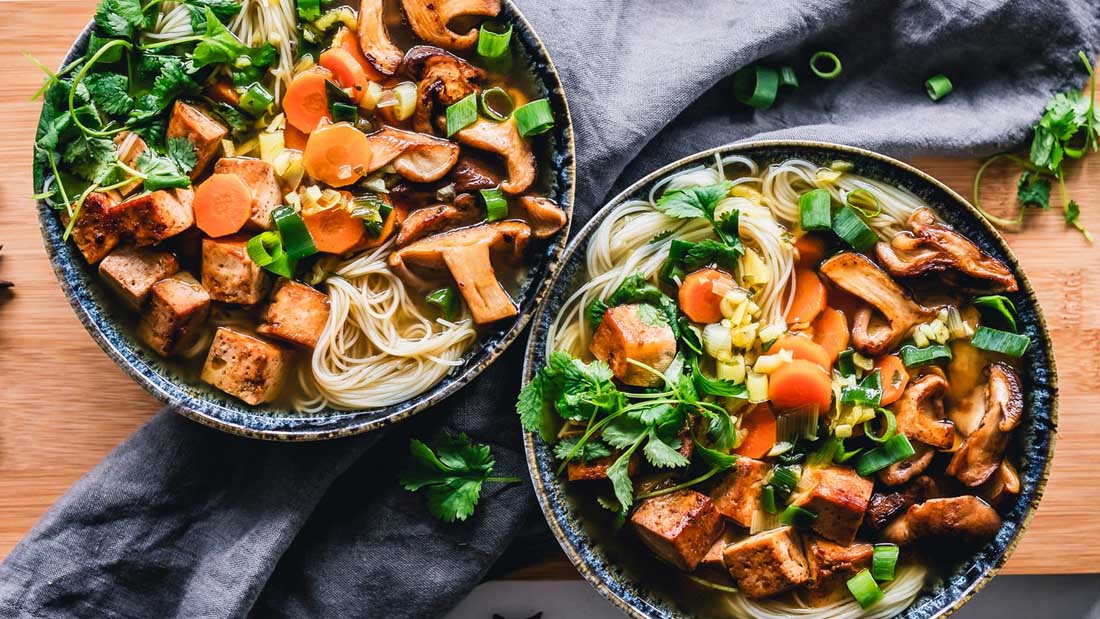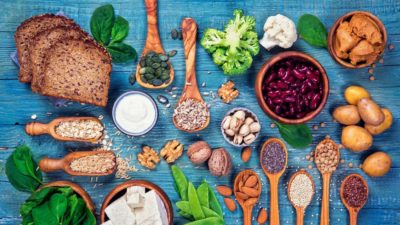Nutrition basics

A varied, wholesome vegan diet is the best choice for anyone who wants their body to perform at its best. However, a vegan diet is not automatically healthy – there are plenty of vegan processed foods out there too! Just as it is not healthy to eat lots of meat and animal products, it’s not the best strategy to eat lots of processed vegan foods as they tend to contain high levels of fat and salt. The main difference from a health perspective is the vegan alternatives are not linked to cancer! It’s a good idea to be aware of nutrition essentials – what we need and where we get it from.
We all need the same set of nutrients but when you’re active, you need a little more of some of them. The nutrients we eat in large amounts – carbohydrates, protein and fat – are called macronutrients – or macros in the world of sports nutrition. And those we only need in tiny quantities are called micronutrients (or micros) – better known as vitamins and minerals. Both groups of nutrients are equally important and essential to our health.
Our bodies are built to use carbohydrates as a primary source of energy. When carbohydrates are digested, they release glucose – sugar – into the bloodstream. Glucose is the principal fuel that every single cell in your body needs, in order to perform all the vital reactions. That’s why carbs are so important for our health and for any kind of physical activity. However, not all carbs are equal – there are three types:
1. Simple carbs – sugars that your body digests quickly. They give you a sugar rush but the energy doesn’t last. In general, we don’t need these but if you’re in the middle of an intense workout and need an immediate energy boost, they can be useful. Simple carbs are mostly in refined foods – sugar, white flour, processed snacks and cakes. These foods have had most of their nutrients stripped and can lead to weight gain and huge energy highs and lows.
2. Complex or starchy carbs – these carbs combine many molecules into very long chains so your body breaks them down slowly and releases glucose gradually. These provide the best source of long-lasting energy throughout the day so should be your carbs of choice. They are found in wholefoods such as wholemeal bread, oats, brown rice, fruit, vegetables, beans, lentils and sweet potatoes. These foods provide a healthy package deal – their complex carbs come with fibre, protein, vitamins, minerals and antioxidants. It means they give you healthy energy and performance-boosting nutrients. Diets based on complex carbohydrates also help to keep your body fat down and improve blood sugar control (1).
3. Fibre – a group of many types of complex carbs that we cannot digest but they keep our guts healthy, slow down energy release from foods and regulate blood sugar and fat. Fibre is absolutely crucial to a healthy diet. The good news is that it’s an essential component of plant wholefoods so if you base your diet around them, you won’t have to worry about a lack of fibre!
What about fruit? It contains some simple carbs – fruit sugar – but also a lot of fibre, which slows down its digestion, so fruit is great for gradual energy release too! Don’t limit your fruit intake.
In case you’re wondering about the importance of healthy carbs – in an eight-week resistance training study, athletes ate diets equal in calories and protein but with different percentages of carbs. The results showed a clear divide – those eating a normal amount of carbs gained 1.3 kg of lean muscle mass but those in the low-carb, ketogenic group gained none (2). It has a simple explanation – carbs enable your body to perform at its best and allow protein to be efficiently used for muscle repair and growth. Low-carb diets force the body to get its energy from fat and protein which is less efficient, so there’s less left for actual muscle maintenance.
Your body has a special storage system for carbs in the muscles and liver. They are stored there as glycogen – a ready-to-use energy store. These stores get depleted after 1.5-2 hours of exercise, depending on intensity, which is when you start to feel tired. If you don’t have enough carbs in your diet, your glycogen stores will be low, so you will experience fatigue earlier on. Later, after your training, low carb intake will also hinder your recovery (3).
To find out how many carbs you need based on your training and goals, see Fuelling Your Performance.
How about low-carb diets?
Low-carb, ketogenic or paleo diets are usually based around foods high in protein and fat, and very low in carbohydrates. This forces your metabolism to switch gears and draw energy mostly from fat and protein, which makes you less hungry and may lead to weight loss. Your body can do this for a while but it’s not a natural way for your metabolism to work. It’s why these diets are effective only for short-term weight loss but if followed for long periods of time, they have a whole range of unpleasant adverse effects such as constipation, headaches, kidney fatigue, bad breath, increased cholesterol levels, increased risk of heart disease, cancer and even premature death (4, 5, 6, 7, 8).
Protein is a vital part of every single one of our cells, which means it’s needed for the growth, maintenance and repair of our muscles, but it is also essential for thousands of everyday reactions in the body and plays a crucial role in the immune and hormonal systems. It forms collagen (the protein that holds your body together) and is needed to make your brain’s messengers (neurotransmitters).
Every molecule of protein consists of different amino acids; they are the building blocks of protein. Our bodies can manufacture some of them but there are nine that we cannot make – they are called essential amino acids and we need them in our diet. Worry not, a varied vegan diet provides more than enough protein and all the essential amino acids in sufficient amounts (1, 2, 3, 4).
Foods that contain all nine essential amino acids in perfect proportions are often viewed as better protein sources and you may have heard them being referred to as ‘complete protein’. Plant examples include soya, buckwheat, quinoa, cashew nuts, chia seeds and pistachios. However, modern nutrition science considers this outdated thinking because if your diet includes a variety of foods and you eat enough calories in a day, you will automatically get all the amino acids you need (4).
All plants contain protein and all of the essential amino acids (5, 6). Certain foods contain more – pulses (soya, chickpeas, beans and lentils), wholegrains (oats, wholemeal bread and pasta, quinoa), nuts and seeds – but all plant-based foods have some protein, unless they are extracts such as oil or sugar.
Plant protein usually comes as a package deal along with some healthy carbs and a generous portion of health-boosting micronutrients – which means it’s not just healthy but also provides all the right nutrients; perfect for supercharging your athletic performance (7, 8).
Contrary to the aggressive marketing of companies selling protein products, it’s not difficult to get enough protein from foods alone. In fact, most of us get too much without even trying (9)! A regular, moderately active person doesn’t need to worry about the protein content of foods – that’s how easy it is. Only when you start training more seriously or you specifically want to gain muscle would you want to increase your intake from foods like beans, lentils, tofu, nuts, seeds, peanut butter, meat alternatives, wholegrains and protein bars. Protein shakes and powders are a good solution if you need something quick post-workout, you prefer liquid meals or have a demanding training schedule.
Consuming protein evenly throughout the day rather than having a large protein dose in one meal is better because that way your muscles have a steady supply of amino acids to work with. Post-workout, you need some protein to maximise muscle repair and for new muscle synthesis – 20 to 40 grams is ideal. Anything more than that isn’t effective as your body has limits to how much protein it can process at a time.
To find out how much protein you need based on your training and goals, see Fuelling Your Performance.

“Every time I talk to people about going vegan, I am asked – if I don’t drink milk, or eat eggs, or meat, then where will I get my protein from? Well, I climbed Everest to debunk this very myth. Yes, protein is important. But stating that protein can only be obtained from animal sources is very much fake news. I have never eaten meat in my entire life and I have successfully been able to build top of the world level muscle and endurance and not only survive but thrive in the -50C temperatures on top of Everest, not just once, but twice! Goes to show that no animal needs to suffer or die for our dreams to come true.“
Kuntal Joisher – mountaineer, summited several Himalayan peaks, Mt Everest twice
Fat is an essential component of cell membranes and brain tissue, it helps the body to absorb fat-soluble vitamins (A, D, E and K) from the diet, provides energy, insulation and protects the body’s vital organs.
Fat is the most energy dense of all the macronutrients. It contains more than twice as many calories weight-for-weight as protein or carbohydrate. That’s why it’s a good source of energy but also why we don’t need too much of it.
Plants tend to store their fats in seeds (nuts, seeds, soya beans and corn), and sometimes in the fleshy layer protecting the seed inside (eg avocados, olives and coconuts). Animals, including humans, mostly store fat within and between their muscles, under the skin and around the organs.
Some fat is healthy and necessary, yet other fat is unhealthy and unnecessary. There are four types of fat we should know about:
1. Saturated fats – fats that are solid at room temperature and come mostly from animal foods, coconut and palm oil. We have no nutritional need for this type of fat because our bodies can make it. Diets high in saturated fat raise blood cholesterol levels and increase the risk of heart disease, stroke, obesity, type 2 diabetes and some types of cancer, such as prostate cancer (1, 2, 3, 4).
2. Trans/hydrogenated fats – these fats are bad news as they increase your risk of heart disease and stroke by raising harmful cholesterol levels. Their effect on blood cholesterol is twice that of saturated fats! Smaller amounts of trans-fats are naturally found in dairy products, lamb and beef fat. Larger amounts can often be found in processed foods. These fats are made by the hydrogenation process, which converts liquid vegetable oils into solid fats. The final product is called hydrogenated vegetable oil/fat – which is essentially just a different term for trans-fats. They are to be avoided at all costs so always check the ingredients on processed foods.
Note on margarine: margarine used to contain hydrogenated/trans-fats and that’s why some people believe it’s unhealthy. However, most manufacturers have since changed their product ingredients so margarine usually doesn’t contain trans-fats anymore (always check the ingredients to be certain).
3. Monounsaturated fats – offer a range of benefits. Monounsaturated fats are found in many plants and vegetable oils. Probably the most common one is oleic acid – an omega-9 fat – the main component of olive, macadamia, avocado and sunflower oil.
4. Polyunsaturated fats – these are the essential omega-3 and omega-6 fats. Plants contain plenty – in particular, nuts, seeds and pulses. It’s easy to get all the omega-6 fats you need from plants, so our attention should be focused more on omega-3s. Rich sources are flaxseed, hempseed, chia seeds and walnuts – and oils made from them (use cold to preserve nutritional value). The best oils to use for cooking are cold-pressed rapeseed (because it’s high in omega-3s) and olive oil.
Omega-3s from plants come in the form of ALA (alpha-linolenic acid) which our bodies convert to EPA (eicosapentaenoic acid) and DHA (docosahexaenoic acid). Fish oils contain ready-made EPA and DHA which is why some people think they are better sources of omega-3s but fish are so contaminated with heavy metals (mercury, cadmium, lead) and pesticide residues that fish oil is not a smart choice – it’s the reason pregnant women and small children are warned against their consumption (5, 6, 7, 8). If you’d rather take a supplement than rely on foods alone, go for algal omega-3s – marine algae manufacture EPA and DHA (that’s where fish get theirs from) and supplements made from them are a super-healthy choice.
To find out how much fat you need based on your training and goals, see Fuelling Your Performance.
Vitamins and minerals are natural compounds that we need in tiny amounts – which is why they’re also called micronutrients. These small amounts, however, are vital to our health. Vitamins and minerals play a crucial role in our metabolism, hormone production and regulation, as part of our cells and tissues and in regulating muscle and nerve function. Some are also antioxidants which protect our bodies from damage caused by free radicals – unstable compounds that can harm our DNA, cells and tissues. Free radicals are a by-product of our metabolism (they are produced naturally in the body) but they also result, in much higher levels, from alcohol consumption, cigarette smoke, environmental pollution, stress and lack of sleep.
Antioxidants disarm free radicals – think of them as sending in the cavalry! There are countless antioxidants in plant foods, such as vitamins A (beta carotene), C and E, selenium, lycopene and polyphenols but there are many, many more. The best strategy to ensure you get enough is to eat plenty of brightly coloured plant foods – fresh fruit and vegetables, black beans, red lentils, wholegrains, nuts with skin on (eg almonds, walnuts, Brazil nuts), edamame, cinnamon, turmeric and even mushrooms.
A varied plant-based diet will automatically provide you with almost all nutrients in sufficient amounts (see Nutrients in a Vegan Diet – overview below). The only two to watch out for are vitamins B12 and D as with our modern lifestyles, we tend to not get enough – vegans and meat-eaters alike! Studies show that some populations have 30-40 per cent of people with inadequate B12 levels (1) and almost as much as 50 per cent of the world population is lacking vitamin D (2).
Vitamin B12 is produced by bacteria in the soil – and before sanitation we used to get it from contaminated fruit and veg – but nowadays even the soil is depleted so we’re best off taking a supplement. It is a common misconception that meat is is naturally rich in vitamin B12; farmed animals are actually given B12 supplements so instead of eating recycled B12 in their flesh, you can go straight to the source! People over the age of 50 are advised to take a supplement regardless of their diet.
Vitamin D is produced in our skin when it’s exposed to sunlight in spring and summer, but during autumn and winter we tend to cover up more, and the sun doesn’t shine so strongly. Also, with increasing numbers of people living and working in cities, we are more shielded from the sun, even in the warmer months. The official advice is to supplement vitamin D at least from October to April, but if you spend most of your time indoors, or always use a sun-cream or cover up, you may need a supplement throughout the year. People with dark skin from African, Afro-Caribbean and South Asian backgrounds, may also need to take a supplement all year round.
Eating a varied plant-based diet makes you thrive and boosts your health better than any other diet. If you want an additional nutritional boost you can always add some powerful natural aids, such as turmeric, ginger, ashwagandha, matcha green tea, moringa leaf powder, ginseng, maca or acai, all of which are strong antioxidants, anti-inflammatory and help you combat stress, but they are not a must.
The following table provides an overview of all the essential nutrients and where to find them. It can be your handy go-to reminder – you can even print and keep it in the kitchen for reference!
| Nutrient, how much we need and why | Best sources |
|---|---|
| Carbohydrates: 2.3-5.4 g/lb of body weight (5-12 g/kg) Energy, healthy digestive system | Oats, wholemeal bread, brown rice, fruit, vegetables, beans, lentils, chickpeas, peas, sweet potatoes, pumpkin, squash, quinoa, wholegrain or buckwheat pasta/noodles |
| Protein: 0.36-1 g/lb of body weight (0.8-2 g/kg) Muscle and tissue structure and repair, hormones, immune system, vital for biochemical reactions in the body, nerve signal transmission | Beans, lentils, chickpeas, peas, soya, tofu, tempeh, plant-based meat alternatives, seitan, nuts, seeds, nut butters, wholegrain products, plant-based protein powders |
| Fat: 0.2-0.7 g/lb of body weight (0.5-1.5 g/kg) Energy, insulation, organ protection, cell membranes, transport of molecules | Nuts, seeds, pulses, avocado, cold-pressed oils. Best for omega-3s: flaxseed, hempseed, chia seeds, walnuts |
| Vitamin A (Beta-carotene*): 0.6-0.7 mg Eye health and vision, skin and mucous membranes, immune system * Beta-carotene is found in plants and the human body converts it to vitamin A according to its needs. | Carrots, pumpkins, butternut squash, sweet potatoes, peppers (red, yellow, orange), spinach, kale, watercress, romaine lettuce, tomatoes, mangoes, apricots, cantaloupe melon |
| B group vitamins: B1 Thiamin: 0.8-1 mg B2 Riboflavin: 1.1-1.3 mg B3 Niacin: 13-17 mg B5 Pantothenic Acid: 5-7 mg B6 Pyridoxine: 1.2-1.4 mg B7 Biotin: 30-40 μg (mcg) B9 Folic Acid: 200-400 μg (mcg) Production of energy from food, protein and fat metabolism, cell division and growth, nerve function, red blood cell production | Nuts, seeds, wholegrains, wheatgerm, legumes/pulses, soya products, corn, green leafy vegetables, yeast extract, bananas, avocados, mushrooms |
| Vitamin B12: 50 μg Nerve cells maintenance, DNA formation, red blood cell production | Supplement or fortified foods - nutritional yeast with B12, plant-based milks, yoghurts and desserts, breakfast cereals and spreads |
| Vitamin C: 40 mg Healthy skin, teeth, bones, cartilage and connective tissue, immune function, wound healing, iron absorption | Strawberries, raspberries, blackcurrants, oranges, grapefruits, lemons, kiwi, mango, papaya, pineapple, peppers, spinach, kale, spring greens, Brussels sprouts, broccoli, cabbage, watercress, tomatoes, potatoes |
| Vitamin D: 10 μg/ 400 IU Regulation of calcium levels in the blood, healthy bones, teeth and muscles | Sunlight on the skin, supplements or fortified foods – breakfast cereals, plant milks, vitamin D mushrooms |
| Vitamin E: 11-15 mg Skin and cell membranes protection and maintenance, immune function | Nuts and seeds (hazelnuts, almonds, sunflower seeds, peanuts, pistachios), wheat germ, sunflower oil, safflower oil, rapeseed oil, margarines and spreads, avocado, butternut squash, canned tomatoes, mango, broccoli, spinach, kale |
| Vitamin K: 60-100 μg Healthy blood clotting, strong bones | Kale, spinach, broccoli, cabbage, Brussels sprouts, lettuce, asparagus, watercress, green beans, peas, cauliflower, runner beans, leeks |
| Calcium: 700-1200 mg Bone structure, muscle function, nerve transmission, cell signalling, hormone formation | Sesame seeds and tahini (sesame seed paste), almonds, tofu (made with calcium sulphate), tempeh, beans, dried figs, kale, collard/spring/mustard greens, watercress, plant-based milks fortified with calcium |
| Chromium: 25 μg Blood sugar regulation, insulin function, protein and fat metabolism | Wholegrains (wholemeal and rye bread, oats), peppers, onion, cabbage, broccoli, romaine lettuce, tomatoes, celery, peaches, bananas, unpeeled apples |
| Copper: 1.2 mg Many enzymes, connective tissue formation, brain and nervous system function | Wholegrains and products made from them, nuts, seeds, beans, lentils, dried apricots, mushrooms, spinach |
| Iodine: 140 μg Production of the thyroid hormones, metabolism regulation, development of the nervous system in infancy and childhood | Seaweed (kombu, arame, wakame and nori), iodised salt. Varying iodine content (depends on iodine levels in the soil): wholegrains, green beans, courgettes, kale, spring/ collard greens, watercress, strawberries, organic potatoes with skin Some plants milks also contain iodine |
| Iron: 8.7 mg – men, women over 50 14.8 mg - women up to the age of 50 Component of the oxygen-carrying molecules haemoglobin and myoglobin, an essential part of many proteins in the body | Wholegrains (wholemeal bread, whole wheat pasta, quinoa, some fortified breakfast cereals), beans, lentils, peas, tempeh, tofu, pumpkin and chia seeds, tahini, dried apricots, prunes, figs, broccoli, spinach, cabbage, black treacle, cocoa, turmeric, thyme |
| Magnesium: 270-300 mg Bone formation, healthy metabolism, production of DNA, energy, muscle and nerve function | Green leafy vegetables, nuts (eg cashews, almonds, Brazil nuts, peanuts, hazelnuts), seeds (pumpkin, sunflower, sesame), oats, pulses/legumes, bananas, apricots, apples, prunes, spinach |
| Manganese: 3 mg Healthy bones, skin, cartilage, nervous system, immune system, sugar metabolism | Wholegrains (whole wheat pasta, bread, oats, brown rice), nuts, seeds, pulses/legumes, soya products, green leafy vegetables, berries |
| Phosphorus: 550 mg Healthy bones and teeth, cells, DNA, energy metabolism | Nuts, seeds, pulses/legumes, corn, parsnips |
| Potassium: 3,500 mg Body fluid balance, nerve signal transmission, heart muscle contractions, kidney health | Pulses/legumes (beans, lentils, soya), potatoes and sweet potatoes, pumpkins and squashes, dried fruit (apricots, figs), avocado, spinach, broccoli, bananas |
| Selenium: 60-75 μg Cell defence, antioxidant, healthy thyroid gland function, fertility | Brazil nuts, sunflower seeds, sesame seeds, wholegrains, tofu, asparagus, mushrooms |
| Sodium: No more than 2.4 g (6 g of salt) Nerve impulses, muscle contraction, fluid balance | Salt |
| Zinc: 7-9.5 mg Cell division, enzymes, processing carbohydrates, fats and protein from food, wound healing, immune system, healthy vision, male reproductive health | Pumpkin and sesame seeds (including tahini), tofu and tempeh, cashews, wholegrains |
See Essential Food Groups for more information about foods, their nutrients and properties!







